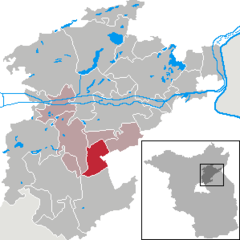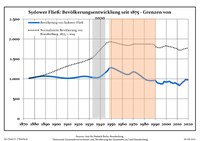Sydower Fließ
Sydower Fließ | |
|---|---|
Location of Sydower Fließ within Barnim district  | |
| Coordinates: 52°45′00″N 13°43′00″E / 52.75000°N 13.71667°E | |
| Country | Germany |
| State | Brandenburg |
| District | Barnim |
| Municipal assoc. | Biesenthal-Barnim |
| Subdivisions | 2 Ortsteile |
| Government | |
| • Mayor (2024–29) | Stefan Seemke[1] |
| Area | |
• Total | 32.31 km2 (12.47 sq mi) |
| Highest elevation | 80 m (260 ft) |
| Lowest elevation | 70 m (230 ft) |
| Population (2022-12-31)[2] | |
• Total | 968 |
| • Density | 30/km2 (78/sq mi) |
| Time zone | UTC+01:00 (CET) |
| • Summer (DST) | UTC+02:00 (CEST) |
| Postal codes | 16230 |
| Dialling codes | 03337 |
| Vehicle registration | BAR |
| Website | www.amt-biesenthal-barnim.de/gemein6.htm |
Sydower Fließ (German pronunciation: [ˈzyːdoːɐ̯ ˈfliːs]) is a municipality in the district of Barnim in Brandenburg in Germany.
History
The municipality of Sydower Fließ was formed on 27 September 1998 by merging the municipalities of Grüntal and Tempelfelde.
From 1815 to 1947, the constituent localities of Sydower Fließ were part of the Prussian Province of Brandenburg, from 1947 to 1952 of the State of Brandenburg, from 1952 to 1990 of the East German Bezirk Frankfurt and since 1990 again of Brandenburg, since 1998 united as Sydower Fließ.
Demography

|
|
|
References
- ^ Landkreis Barnim Wahl der Bürgermeisterin / des Bürgermeisters. Retrieved 27 June 2024.
- ^ "Bevölkerungsentwicklung und Bevölkerungsstandim Land Brandenburg Dezember 2022" (PDF). Amt für Statistik Berlin-Brandenburg (in German). June 2023.
- ^ Detailed data sources are to be found in the Wikimedia Commons.Population Projection Brandenburg at Wikimedia Commons



